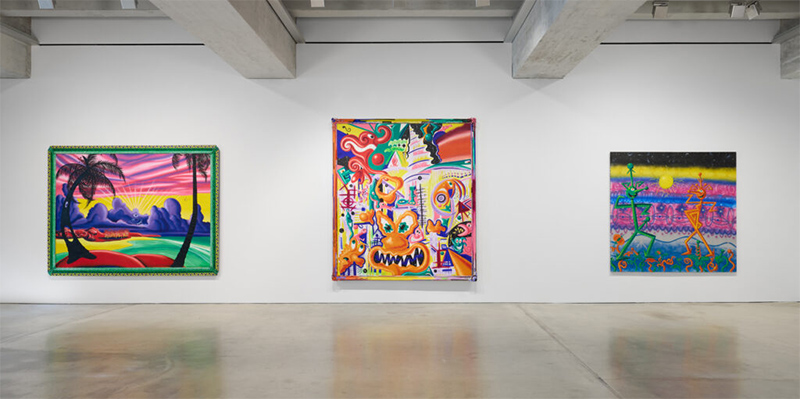케니 샤프(Kenny Scharf) 회고전@브랜트파운데이션(11/13-2/28, 2025)
KENNY SCHARF
November 13, 2024 - February 28th, 2025
The Brant Foundation I: 421 East 6th St, New York

Photography Tom Powel Imaging
The Brant Foundation is pleased to announce the opening of a major survey of pioneering artist, Kenny Scharf. Opening November 13, 2024, the exhibition brings together over 70 paintings, sculptures, and objects created throughout the artist’s expansive career, beginning with works from the late seventies. The survey is compiled from the Brant collections as well as major loans from institutions and private collections, including The Whitney Museum of American Art (New York) and The Broad (Los Angeles). Kenny Scharf is co-curated by Peter M. Brant and Tony Shafrazi in close collaboration with the artist.
Rising to popularity in the 1980s, during the East Village’s vibrant interdisciplinary art scene, alongside peers such as Keith Haring and Jean-Michel Basquiat, Kenny Scharf (b. 1958, Hollywood, CA) pioneered the street-art movement. Scharf articulated a distinct artistic language that has endured throughout his practice. During this period, he also counted Warhol as a mentor, and the famed popartist’s impact on the young Scharf can be seen today in his appropriation of comic book figures and other pop culture icons, shown in Jetsons (1980) and Elroy Explanation (1981).
Scharf’s surrealist, psychedelic scenes burst with a comical sensibility and playful spirit. His seminal painting, When the Worlds Collide (1984), which was included in the 1985 Whitney Biennial, is indicative of his enduring style and dynamic canvases. The artwork, created in a monumental scale, features cartoonish figures, whirling–almost moving–patterns, and highly contrasted colors. On the bottom right of the painting is Scharf’s version of Keith Haring’s classic baby figures, painted as an homage to the artist for allowing Scharf to use his studio to create the work. Scharf’s use of acrylic spray paint on canvas nods to his street-art style that was rarely seen or exhibited in museums or galleries. Scharf stated, “this painting is my idea of showing how everything exists at the same time. There’s peace; there’s chaos…everything exists all together.1” Whereas the painting is clearly influenced by “fun” as the artist has suggested, there is also an underlying anxiety to the work stemming from Scharf’s fear of nuclear catastrophe and other contemporary concerns. Amongst these chaotic scenes are Scharf’s jungle paintings, perhaps most notably Juicy Jungle (1984). Filled with characteristically amusing plants and figures with cartoonish faces, the canvas is absolutely brimming with color and action. In his pop-surrealist style, a term coined by Scharf, the artist toys with the balance between unease and humor in his encompassing works.
In addition to these outlandish figures, Scharf’s early works often meditated on contemporary society in caricatures of the middle-class set against apocalyptic scenes. George Simpson’s Barbecuing (1978) depicts the quintessential American man preparing hot dogs over a charcoal grill, yet instead of a backyard, this scene takes place in a bathroom where fictional vines grow from the sink and bathtub. In another painting from the same year, Barbara Simpson’s New Kitchen, a QVC-esque scene of a woman in a pink kitchen is interrupted by a dragon figure looking directly at the viewer. Both comic and subversive, Scharf conveys the angst around the failed promises of the American dream.
While Scharf is perhaps best known for his fantastical and metaphysical works, Kenny Scharf will also feature several portraits of the artist’s friends and other art-world contemporaries during the early 2000’s. In Baccanalba (Alba Clemente) (2003), the actress, artist, and costume designer is transformed as a wine goddess with blue grapes for hair, staring off into a strange world. Ed Head (Ed Ruscha) (2001) portrays the fellow artist as a detached blue-skinned head floating through space; and writer, musician and poet Patti Smith is depicted as a Pharaoh wearing a leopard fur coat in Patti Smith (1978). These portraits show a lesser-known side of Scharf’s work—his circle of friends and collaborators.
Kenny Scharf’s ingenuitive and unconventional attitudes towards art is a source of inspiration to a number of artists today. With this exhibition, the Brant Foundation’s East Village location continues its commitment to showcasing major exhibitions of artists associated with the neighborhood’s historical and pivotal art scene. After previous exhibitions of Jean-Michel Basquiat (2019) and Andy Warhol (2023), Kenny Scharf, brings a major survey of Scharf’s work back to his roots.
https://www.brantfoundation.org




 갤러리 장(Gallery Chang) 셰인 구포그(Shane Guffogg) 개인전(10...
갤러리 장(Gallery Chang) 셰인 구포그(Shane Guffogg) 개인전(10...
 메트오페라 리즈 데이비슨 주연 '토스카' 세계 1,800개 영화관 상...
메트오페라 리즈 데이비슨 주연 '토스카' 세계 1,800개 영화관 상...

